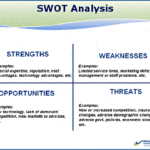SWOT Analysis Revisited: Sharpen Your Competitive Strategy
 Your periodic SWOT Analysis (Strengths, Weaknesses, Opportunities, Threats) is an excellent self-evaluation tool that every medical practice can use to maintain a steady strategic course. A classic, but easily cured, problem with SWOT is that it’s not used often enough.
Your periodic SWOT Analysis (Strengths, Weaknesses, Opportunities, Threats) is an excellent self-evaluation tool that every medical practice can use to maintain a steady strategic course. A classic, but easily cured, problem with SWOT is that it’s not used often enough.
For a group practice, hospital or health system, we recommend looking at these significant issues every six months. Consider this to be a timely reminder, and as the nation’s healthcare system is constantly reinventing itself, the competitive landscape grows ever steeper. The only constant, it seems, is change, and it’s time to revisit your four-quadrant SWOT chart.
Begin with a quick review of the basics in our earlier, and detailed article, SWOT: The High-Level Self-Exam that Boosts Your Bottom Line. If it’s been a while, it’s helpful to visualize the SWOT Analysis form as a completely candid picture of the POSITIVE (Internal Strengths and External Opportunities), as well as the NEGATIVE (Internal Weaknesses and External Threats).
|
|
Internal |
External |
|
Positive: |
Strengths |
Opportunities |
|
Negative: |
Weaknesses |
Threats |
STRENGTHS and WEAKNESSES are internal considerations that you can control. OPPORTUNITIES and THREATS are external factors where you have no direct control.
STRENGTHS: List of your capabilities and resources that can be the basis of a distinct competitive advantage.
WEAKNESSES: What areas need improvement or are barriers to success?
OPPORTUNITIES: What new or significant trends and other external opportunities exist and how can you exploit or benefit from each?
THREATS: What external factors stand in the way of your success.
Above all, your assessment must be realistic and objective. There’s no value in overstating the positives or dismissing the negatives.
Tips for Getting the Most from Your SWOT Analysis
- Carve out quiet time to accomplish with limited interruptions. Consider an out-of-office planning “retreat.”
- Use an objective third-party for an unbiased perspective.
- Involve your entire team in the process. They will bring fresh perspectives and new ideas. Part of the value is teambuilding with an ownership investment in success.
- Remain open-minded and realistic. Don’t automatically discard worthwhile items as “impractical” or “costly.”
- Create specific solutions, goals and action plans. Quantify expectations with responsibilities, timetables and resources.
- Calendar interim progress reviews and your next SWOT update.
A clear and pragmatic view of where you stand today provides the platform for launching the strategies and tactics required to reach your goals. An up-to-date SWOT Analysis is a vital planning tool, as well as a means to inform and align your team with strategic objectives and the path to success.
For additional resources on this topic, see our previous articles, SWOT: The High-Level Self-Exam that Boosts Your Bottom Line, What Is A Health Care Marketing Plan? and 4 Tested Ways to Uncover New Healthcare Business Opportunities.








